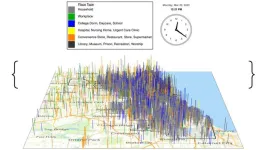(Press-News.org) Modeling the emergence and spread of biological threats isn’t as routine as forecasting the weather, but scientists in two of the U.S. Department of Energy’s (DOE) national laboratories were awarded funding to try to make it so.
DOE’s Argonne National Laboratory and Sandia National Laboratories were one of the three projects to receive a total of $5 million from DOE to advance computational tools to better prepare for natural and human-created biological threats. The laboratories will work together to harness Sandia’s algorithms of real-world outcomes to Argonne’s high performance models that address spread transmission and control of diseases.
“Our whole point in doing this type of work is to make the process routine, more akin to weather forecasting or other domains where a large computational infrastructure is dedicated to continuously adjusting the models automatically as new data is obtained.” — Jonathan Ozik, principal computational scientist, Argonne National Laboratory
The projects fall under the DOE Office of Science’s new Bio-preparedness Research Virtual Environment initiative, which focuses on developing scientific capabilities that aid in the prevention and response to potential biothreats.
“We want models that mimic reality,” said Jonathan Ozik, principal computational scientist at Argonne. “By calibrating them, we will be able to trust that outcomes from computational experiments carried out with the models have a good chance of meaningfully reflecting reality.”
Those outcomes can provide insight into the intricacies of disease transmission as well as the effectiveness of vaccination efforts. Provided to municipal and state public health officials, the outcomes could serve as potential guidelines for the development of mitigation initiatives.
The disease model Argonne developed was first used in the early 2000s when a MRSA epidemic emerged in Chicago. The same model was later applied to the threat of an Ebola outbreak in 2014.
More recently, Argonne researchers developed CityCOVID, a highly refined version of the model, to simulate the spread of COVID-19 in Chicago. By forecasting new infections, hospitalizations and deaths, the model provided a computational platform for investigating the potential impacts of nonpharmaceutical interventions for mitigating the spread of COVID-19. It was chosen as one of only four finalists for the 2020 ACM Gordon Bell Special Prize for High Performance Computing-Based COVID-19 Research, which recognized outstanding research achievement towards the understanding of the COVID-19 pandemic through the use of high performance computing (HPC).
Developing such models, known as agent-based modeling (ABM), is a complex effort and HPC becomes critical. This is due to the large amount of data the model requires, the number of parameters researchers must take into account and additional factors or inputs that combine to make the model as accurate as possible.
“Getting access to the data, landing on the right parameters and evolving the best fit of information that is timely and relevant to decision makers are among the biggest problems we face,” said Charles “Chick” Macal, chief scientist for Argonne’s Decision and Infrastructure Sciences division and its social, behavioral and decision science group leader. “A large component of the work that we do as part of the biopreparedness project is to develop high performance computing workflows to improve the computational techniques, to make them more efficient.”
The parameters and factors have to predict real-world targets that researchers want to understand, like number of hospitalizations, deaths and vaccinations. To get it right, researchers run simulations over and over — sometimes hundreds of thousands of times — adjusting parameters until the model mimics what the data is telling them.
Making sure these components align, and reducing the number and run-time of the simulations, is where Sandia’s efforts come into play. Like Argonne, Sandia already had roots in computational epidemiology, starting with the anthrax scare of 2003. Later work focused on smallpox and, most recently, COVID.
For this project, Argonne’s computing infrastructure will be adapted to automatically apply Sandia-developed calibration algorithms as parameters for the epidemiological models change or new ones come to light.
“We are the guys who search out those parameters,” said Sandia’s Jaideep Ray, principal investigator of the project.
One of the most important parameters is the unknown spread rate of the disease, according to Ray. Calibrating the model predictions to real data — much of it from Chicago and New Mexico COVID-19 data and other public health surveillance sources — by optimizing the spread rate over several weeks of simulation runs and data collection allows the model to forecast future case counts in an epidemic.
“If the forecasts are right, then we know we have the right set of parameters,” said Ray.
When it comes to infectious disease epidemics, time is of the essence. Naïve calibration, which requires running an ABM thousands of times, is neither efficient nor practical. By using an artificial intelligence method called machine learning, researchers can construct and train a metamodel — a model of their ABM — that can run in seconds. The results can then be used by the machine to “learn” the spread-rate from epidemic data and make forecasts.
While the process may sacrifice the accuracy of long-term forecasts, it could generate faster, short-term forecasts that reduce computational expense and set mitigation efforts in motion more quickly.
“Our whole point in doing this type of work is to make the process routine, more akin to weather forecasting or other domains where a large computational infrastructure is dedicated to continuously adjusting the models automatically as new data is obtained,” said Ozik. “We can then provide short-term forecasts and the ability to run longer-term scenarios that answer specific stakeholder questions.”
While Chicago served as the testbed for this model, the team expects to generalize their methods for application to any other place in the world.
Award funding was provided by the DOE’s Advanced Scientific Computing Research program, which manages the development of computational systems and tools for the DOE.
Argonne National Laboratory seeks solutions to pressing national problems in science and technology. The nation’s first national laboratory, Argonne conducts leading-edge basic and applied scientific research in virtually every scientific discipline. Argonne researchers work closely with researchers from hundreds of companies, universities, and federal, state and municipal agencies to help them solve their specific problems, advance America’s scientific leadership and prepare the nation for a better future. With employees from more than 60 nations, Argonne is managed by UChicago Argonne, LLC for the U.S. Department of Energy’s Office of Science.
The U.S. Department of Energy’s Office of Science is the single largest supporter of basic research in the physical sciences in the United States and is working to address some of the most pressing challenges of our time. For more information, visit https://energy.gov/science.
END
Projects to fight biological threats receive $5 million in federal funding
Scientists at two national laboratories will work together to advance computational tools and solutions for known and unknown diseases
2023-04-05
ELSE PRESS RELEASES FROM THIS DATE:
MSU study confirms: 1 in 5 adults don’t want children –– and they don’t regret it later
2023-04-05
EAST LANSING, Mich. – Last summer, researchers at Michigan State University reported that one in five Michigan adults, or about 1.7 million people, don’t want children and therefore are child-free. Although that number was surprisingly large to many data has now been confirmed in a follow-up study.
“We found that 20.9% of adults in Michigan do not want children, which closely matches our earlier estimate of 21.6%, and means that over 1.6 million people in Michigan are child-free,” said Jennifer Watling Neal, MSU professor of psychology ...
Sleep problems? You may have an increased risk of stroke
2023-04-05
EMBARGOED FOR RELEASE UNTIL 4 P.M. ET, WEDNESDAY, APRIL 5, 2023
MINNEAPOLIS – People who have sleep problems may be more likely to have a stroke, according to a study published in the April 5, 2023, online issue of Neurology®, the medical journal of the American Academy of Neurology. Sleep problems included getting too much or too little sleep, taking long naps, having poor quality sleep, snoring, snorting and sleep apnea. In addition, those who had five or more of these symptoms had an even greater risk of stroke. The study does not show that sleeping problems cause stroke. It only shows an association.
“Not only do our results suggest that individual sleep problems ...
For people with Parkinson’s disease, quality of life linked to race, ethnicity
2023-04-05
EMBARGOED FOR RELEASE UNTIL 4 P.M. ET, WEDNESDAY, APRIL 5, 2023
MINNEAPOLIS – Among those living with Parkinson’s disease, Black, Hispanic and Asian people were found to have a lower health-related quality of life than white people, according to a new study published in the April 5, 2023, online issue of Neurology® , the medical journal of the American Academy of Neurology.
Health-related quality of life is a measure of a person’s level of comfort, health and happiness.
Parkinson’s disease is a disorder of the central nervous system that causes uncontrolled movements, stiffness and loss of balance. It can be debilitating. ...
Exposure therapy to feared foods may help kids with eating disorders
2023-04-05
HERSHEY, Pa. — Whether you’re afraid of dogs, needles or enclosed spaces, one of the most effective interventions for this type of anxiety disorder is exposure therapy in which you confront your fear in a safe environment. A new study led by researchers at Penn State College of Medicine finds that exposure therapy is also a promising treatment for adolescents with eating disorders. They found that exposure to feared foods — such as candy bars and pizza — helped kids who were in a partial hospitalization program for eating disorders experience decreased anxiety toward food.
“As ...
UMass Amherst research finds surprising science behind bumblebee superfood
2023-04-05
AMHERST, Mass. – It’s the spines. This is the conclusion of two new papers, led by researchers at the University of Massachusetts Amherst, showing that the spiny pollen from plants in the sunflower family (Asteraceae) both reduces infection of a common bee parasite by 81 – 94% and markedly increases the production of queen bumble bees. The research, appearing in Functional Ecology and Proceedings of the Royal Society B: Biological Sciences, provides much-needed food for thought in one of the most ...
Hundreds of very shallow earthquakes detected in California’s Long Beach and Seal Beach
2023-04-05
Seismic arrays deployed in California’s Long Beach and Seal Beach areas detected more than a thousand tiny earthquakes over eight months, many of them located at surprisingly shallow depths of less than two kilometers below the surface.
The findings, reported in Seismological Research Letters, confirm that the region’s portion of the Newport-Inglewood fault splays widely at these shallow depths, showing for the first time with seismic evidence that it may spread out by more than a kilometer.
The destructive 1933 magnitude 6.4 Long Beach earthquake may have ruptured in part on the Newport-Inglewood fault. ...
People misremember events within just seconds, often re-shaping their memories to fit their expectations
2023-04-05
People misremember events within just seconds, often re-shaping their memories to fit their expectations
###
Article URL: https://journals.plos.org/plosone/article?id=10.1371/journal.pone.0283257
Article Title: Seeing Ɔ, remembering C: Illusions in short-term memory
Author Countries: The Netherlands, Canada
Funding: AKS is grateful to the European Research Council (ERC-2020-ADG, grant 1010192654) for support. END ...
Hypergentrification of NYC neighborhoods is associated with better mental health for White populations, but not among Black and Latino populations
2023-04-05
Hypergentrification of NYC neighborhoods is associated with better mental health for White populations, but not among Black and Latino populations
###
Article URL: https://journals.plos.org/plosone/article?id=10.1371/journal.pone.0283191
Article Title: Can changing neighborhoods influence mental health? An ecological analysis of gentrification and neighborhood-level serious psychological distress—New York City, 2002–2015
Author Countries: USA
Funding: The authors received no specific funding for this work. END ...
Researchers tend to co-author with individuals of the same gender, partly because of demography, norms and gender representation, but seemingly also through personal preference
2023-04-05
Researchers tend to co-author with individuals of the same gender, partly because of demography, norms and gender representation, but seemingly also through personal preference
###
Article URL: https://journals.plos.org/plosone/article?id=10.1371/journal.pone.0283106
Article Title: Gender-based homophily in collaborations across a heterogeneous scholarly landscape
Author Countries: USA
Funding: This research was supported by the Royalty Research Fund Grant #A118374 awarded to EE (PI) and CL (co-PI), National Science Foundation Grant #1735194 awarded to JW (co-PI), and National Science Foundation SMA 19-52069 to CTB. https://www.washington.edu/research/or/royalty-research-fund-rrf/; ...
Smartphone plant identification apps may not be accurate enough to be relied on, especially in avoiding toxic plants when foraging
2023-04-05
Smartphone plant identification apps may not be accurate enough to be relied on, especially in avoiding toxic plants when foraging
###
Article URL: https://journals.plos.org/plosone/article?id=10.1371/journal.pone.0283386
Article Title: A repeatable scoring system for assessing Smartphone applications ability to identify herbaceous plants
Author Countries: Ireland, UK
Funding: The authors received no specific funding for this work. END ...
LAST 30 PRESS RELEASES:
School meals could unlock major gains for human and planetary health
Menopause hormone therapy does not appear to impact dementia risk
Signature patterns of brain activity may help predict recovery from traumatic brain injury
Dresden study uncovers new key mechanism in cancer cells
New species are now being discovered faster than ever before, study suggests
Cannabis-based products show limited short-term benefit for chronic pain, with increased risk of adverse effects
Cannabis products with more THC slightly reduce pain but cause more side effects
Clearing the brain of aging cells could aid epilepsy and reduce seizures
Brain injuries linked with potential risk of suicide, new study finds
New technique lights up where drugs go in the body, cell by cell
New study finds movement of fishing fleets can reveal shifts in marine ecosystems
Embargoed: New evidence points to potential treatment for vascular dementia
Study uncovers disrupted brain balance in alcohol dependence
Working in groups can help Republicans and Democrats agree on controversial content moderation online
Structural findings reveal how distinct GPCR ligands create different levels of activation
Anything-goes “anyons” may be at the root of surprising quantum experiments
UC review: Maximizing workplace opportunity for veterans
From generation to complex control: Metasurfaces make perfect vortex beams "within reach"
Thin-film lithium niobate-based detector: recent advances and perspectives
Exploring why some people may tend to persistently make bad choices
How cells balance their protein levels
Nirsevimab vs RSVpreF vaccine for RSV–related hospitalization in newborns
Effectiveness and impact of maternal RSV immunization and nirsevimab on medically attended RSV in US children
AI gives scientists a boost, but at the cost of too many mediocre papers
Next-generation vision model maps tree growth at sub-meter precision
Genes aren’t destiny for inherited blindness, study shows
MIT study: High-fat diets make liver cells more likely to become cancerous
Exposure to multiple fine particulate matter components and incident depression in the US Medicare population
Risk of burdensome health care spending over time in the US
Nirsevimab against hospitalizations and emergency department visits for lower respiratory tract infection in infants
[Press-News.org] Projects to fight biological threats receive $5 million in federal fundingScientists at two national laboratories will work together to advance computational tools and solutions for known and unknown diseases





